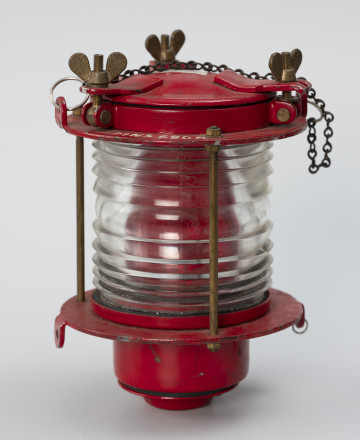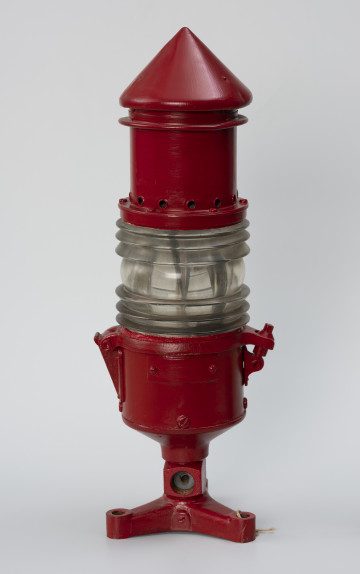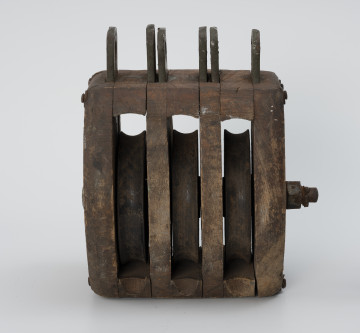
Electric ship lantern
1970 — 1979
National Museum in Szczecin
Part of the collections: Equipment of watercrafts, Navigation history
Ship lanterns fitted with a Fresnel lens were used on vessels as beacons. Their purpose was to inform other vessels in the vicinity, whether on open water or on a fairway, of the location of the vessel carrying it. Both the location of navigation lights and their colours are regulated by international arrangements and requisites that were written up in the late 19th century. The chosen principle of three colours of lights, green, red and white was borrowed from regulations used in the UK. The red light indicates a vessel's port (left) side; the green indicates a vessel's starboard (right) side, and the white light is displayed off the stern and mast. And for larger vessels, there should be two lights on the mast. A Fresnel lens is made up of concentric annular sections with stepwise discontinuities between them so that it can send out a more concentrated beam of light. It is often constructed with a dispersive and a converging layer. It has the advantage of being thinner than a traditional lens, which is particularly important for lenses with large diameters. An important feature of Fresnel lenses is the distortion of the course of the light rays created at the edges of the ring, which is why they are often used for various types of reflectors. Designed in 1822 by Augustin Jean Fresnel (1788-1827) based on a publication by Georges-Louis Leclerc de Buffon (1708-1788) describing this invention. The featured lantern was manufactured by the German company Ahlemann & Schlatter of Bremen, founded in 1868, which now operates under the name aqua signal AG. It emitted white light at an angle of 135 degrees. It was therefore mounted on the stern, providing the view of the vessel from behind. Leszek Kocela
Author / creator
Object type
signal lantern, kerosene lamp, navigational aid
Technique
batch production
Material
metal, glass
Origin / acquisition method
purchase
Creation time / dating
Creation / finding place
Owner
Muzeum Narodowe w Szczecinie
Identification number
Location / status

1970 — 1979
National Museum in Szczecin

1950 — 1959
National Museum in Szczecin

1901 — 1950
National Museum in Szczecin
DISCOVER this TOPIC
Museum of King Jan III's Palace at Wilanów
DISCOVER this PATH
Educational path